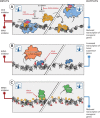Epigenetic modifications of histones in cancer
- PMID: 31747960
- PMCID: PMC6868810
- DOI: 10.1186/s13059-019-1870-5
Epigenetic modifications of histones in cancer
Abstract
The epigenetic modifications of histones are versatile marks that are intimately connected to development and disease pathogenesis including human cancers. In this review, we will discuss the many different types of histone modifications and the biological processes with which they are involved. Specifically, we review the enzymatic machineries and modifications that are involved in cancer development and progression, and how to apply currently available small molecule inhibitors for histone modifiers as tool compounds to study the functional significance of histone modifications and their clinical implications.
Conflict of interest statement
The authors declare that they have no competing interests.
Figures


References
Publication types
MeSH terms
Grants and funding
LinkOut - more resources
Full Text Sources

